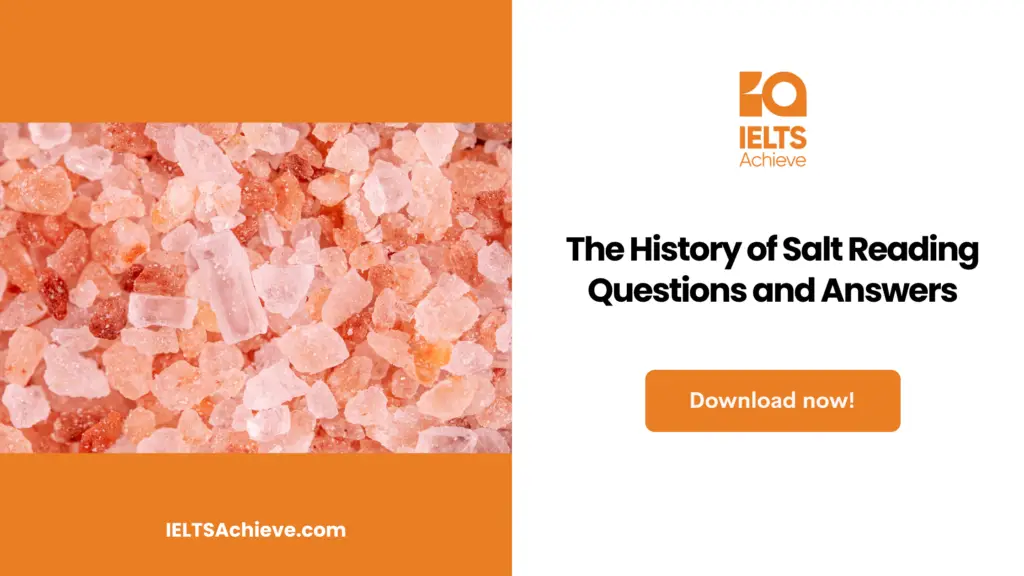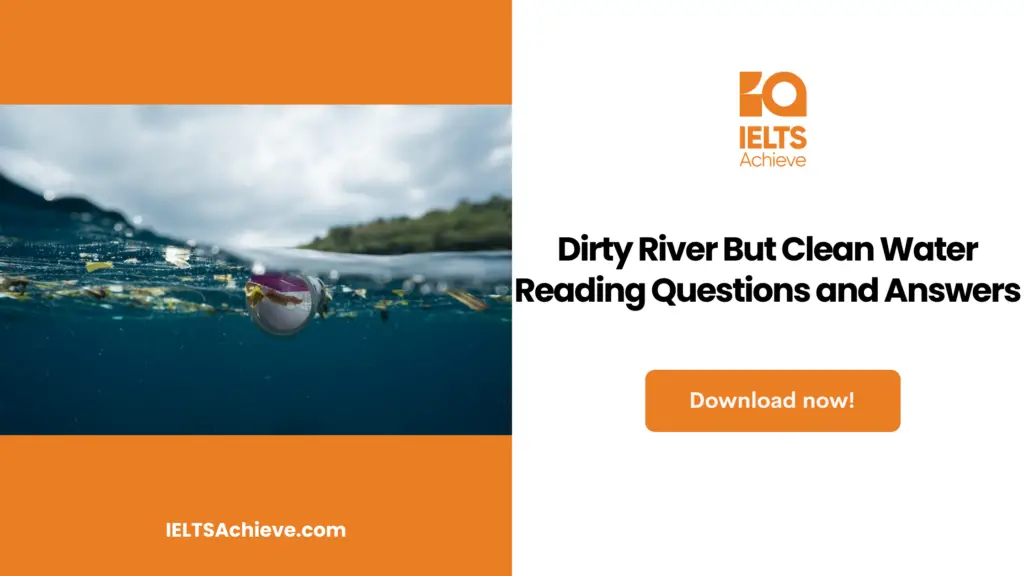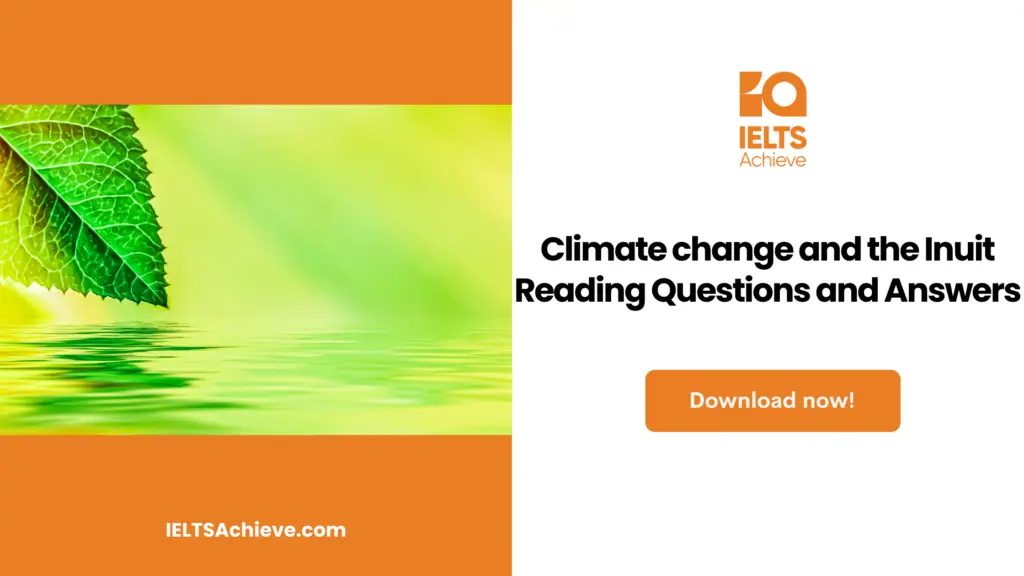The Blog post contains the following IELTS Reading Questions:
- IELTS reading matching features questions
- IELTS reading summary completion questions
- IELTS reading true false not given questions
Stay informed and prepared for success – Explore our comprehensive Reading Test Info page to get valuable insights, exam format details, and expert tips for mastering the IELTS Reading section.
IELTS Reading Passage – The History of Salt

The History of Salt
We practically take salt for granted since it is so straightforward and common. One of the most fundamental compounds on earth, salt is made up of two ions, sodium, and chloride, according to chemical theory. Furthermore, it is one of the most abundant: it has been calculated that the salt reserves beneath the state of Kansas alone could provide all of the world’s demands for the next 250,000 years.
However, salt is also a crucial component. Without it, life would be impossible since the human body needs the mineral to operate correctly. The concentration of sodium ions in the blood is directly connected to the maintenance of normal body fluid levels. We are all aware of the various applications for this element in cooking, but we may not be aware of its 14,000 commercial uses for it. Salt plays an important role in our everyday lives, from the production of pulp and paper to the set of colors in fabrics, from the production of soaps and detergents to the safety of our roads in the winter.
Throughout history, salt has played a significant and enduring role. It has played a significant role in the development of social, political, religious, and economic systems since the birth of civilization. It has inspired mythology, superstition, and even acts of violence all throughout the globe. It has even been used as money.
Salt has always been a vital component of economies since it is a valuable and transportable resource. In fact, the natural surface salt deposits observed there led scholar M.R. Bloch to hypothesize that civilization first emerged around the margins of the desert. Bloch also suggested that the first conflict, which took place near the ancient city of Assault on the Jordan River, may have been fought over the city’s valuable deposits of the mineral.
One of the earliest taxes recorded was enforced by the Chinese monarch Hsia Yu in 2200 BC. He assessed salt. Small salt cakes imprinted with the Grand Khan were used as currency in Tibet, according to Marco Polo, and the Danakil Plains nomads of Ethiopia still use them today. Greek slave dealers often exchanged it for slaves, giving origin to the phrase “not worth his salt” when referring to someone. A solarium, the Latin word for “salary,” was the currency used to pay Roman legionnaires.
This mineral was valued equally to books and gold by merchants in Timbuktu, the center of learning and the entrance to the Sahara Desert, in the 12th century. In order to pay for his acquisition of the Kingdom of Naples, Charles of Anjou imposed the “gabelle,” a salt tax, on France in 1259. The French Revolution was sparked by outrage about the gabelle. Although the tax was abolished by the revolutionaries soon after Louis XVI, the gabelle was reinstated by the Republic of France at the beginning of the 19th century, and it was only officially abolished in 1946.
The Erie Canal, which opened in 1825 and linked the Great Lakes to New York’s Hudson River, was dubbed “the ditch that salt built.” Half of the cost of building the canal was covered by salt tax income. A thriving illicit market for white crystal resulted from the British monarchy’s use of hefty salt taxes to fund its own existence. The Earl of Dundonald reported in 1785 that 10,000 people were detained for salt smuggling in England each year. Mahatma Gandhi also conducted a 200-mile march to the Arabian Ocean in 1930 as part of a protest against British rule to gather untaxed salt for India’s underprivileged.
Greek worshipers consecrated salt in ancient rites, giving it a significant role in both religion and society. It is also traditional to toss salt over your shoulder before entering your home after burial because, according to Buddhist tradition, doing so frightens away any bad spirits that could be clinging to your back. It is also used to cleanse a region in the Shinto faith. A handful is tossed into the middle of the ring before the sumo wrestlers enter for the bout, which is really a complex Shinto ritual, to ward off evil spirits.
The Pueblo people of the American Southwest revere the Salt Mother. Other aboriginal groups had stringent limitations on who might consume salt. According to Hopi folklore, the furious Warrior Twins punished humanity by locating lucrative salt mines far from civilization, requiring hard effort and courage to extract the valuable mineral. The Dalai Lama was buried sitting up on a bed of salt in 1933. Today, a gift of salt is still considered a powerful sign of good luck and a nod to Mahatma Gandhi’s independence of India.
During times of conflict, when human bodies and national economies are taxed to their maximum, the impacts of salt deprivation are accentuated. Thousands of Napoleon’s men perished during the French retreat from Moscow as a consequence of poor wound healing and illness resistance caused by salt deprivation.
Unlock your full potential in the IELTS Reading section – Visit our IELTS Reading Practice Question Answer page now!
Recommended Questions:
Renewable Energy IELTS Reading Question with Answer
The History of Salt IELTS Reading questions
Question 1–3
Choose three letters from A-H.
Which THREE statements are true about salt?
A. A number of cities take their names from the word salt.
B. Salt contributed to the French Revolution.
C. The uses of salt are countless.
D. Salt has been produced in China for less than 2000 years.
E. There are many commercial applications for salt.
F. Salt deposits in the state of Kansas are vast.
G. Salt has few industrial uses nowadays.
H. Slaves used salt as a currency.
Improve your performance in Matching Features questions by clicking here to access our comprehensive guide. Learn how to match specific features or characteristics with the options provided in the IELTS Reading section.
Question 4–8
Complete the summary.
Choose NO MORE THAN TWO WORDS from the passage for each answer. Write your answers in boxes 17-21 on your answer sheet.
Salt is such a 4…………………….that people would not be able to live without it. As well as its uses in cooking, this basic mineral has thousands of businesses 5…………………….ranging from making paper to the manufacture of soap. Being a prize and 6…………………………., it has played a major part in the economies of many countries. As such, salt has not only led to war but has also been used to raise 7……………………by governments in many parts of the world. There are also many instances of its place in religion and culture, being used as a means to get rid of evil 8……………………..
Boost your performance in Summary, Notes, Table, and Flowchart Completion tasks. Click here to explore our detailed guide and learn how to effectively complete summaries, notes, tables, and flowcharts in the IELTS Reading section.
Question 9–14
Do the following statements agree with the information in the Reading Passage?
TRUE if the statement agrees with the information.
FALSE if the statement contradicts the information.
NOT GIVEN if there is no information about the statement.
9. It has been suggested that salt was responsible for the first war.
10. The first tax on salt was imposed by a Chinese emperor.
11. Salt is no longer used as a form of currency.
12. Most of the money for the construction of the Erie Canal came from salt taxes.
13. Hopi legend believes that salt deposits were placed far away from civilization to penalize mankind.
14. A lack of salt is connected with the deaths of many of Napoleon’s soldiers during the French retreat from Moscow.
Enhance your skills in identifying information as True, False, or Not Given. Click here to discover expert strategies and techniques for mastering this question type in the IELTS Reading section.
Unlock your full potential in the IELTS Reading section – Visit our IELTS Reading Practice Question Answer page now!
Recommended Questions:
Renewable Energy IELTS Reading Question with Answer
The History of Salt Reading Answers
1. B.
2. E.
3. F.
4. Essential element.
5. Applications.
6. Portable commodity.
7. Taxes.
8. Spirits.
9. True.
10. Not Given.
11. False.
12. False.
13. True.
14. True.

We hope you found this post useful in helping you to study for the IELTS Test. If you have any questions please let us know in the comments below or on the Facebook page.
The best way to keep up to date with posts like this is to like us on Facebook, then follow us on Instagram and Pinterest. If you need help preparing for the IELTS Test, join the IELTS Achieve Academy and see how we can assist you to achieve your desired band score. We offer an essay correction service, mock exams and online courses.

